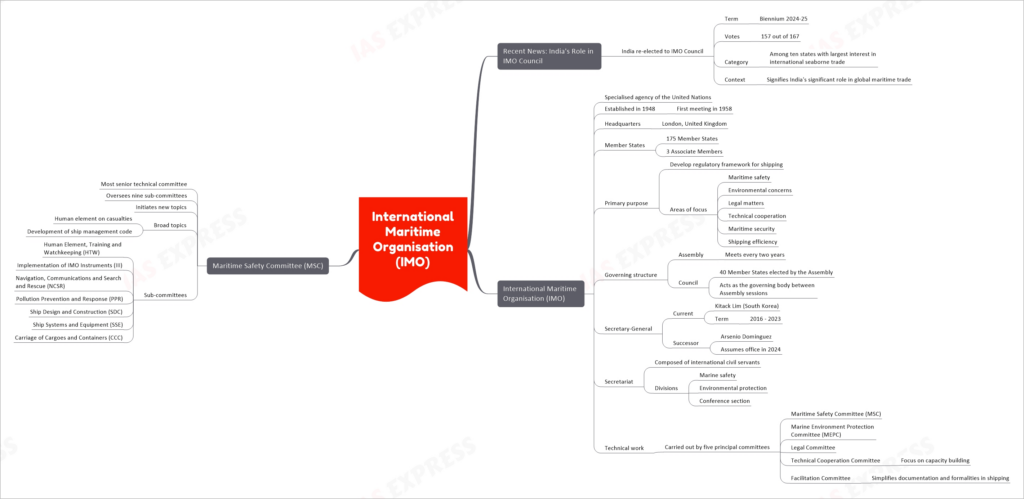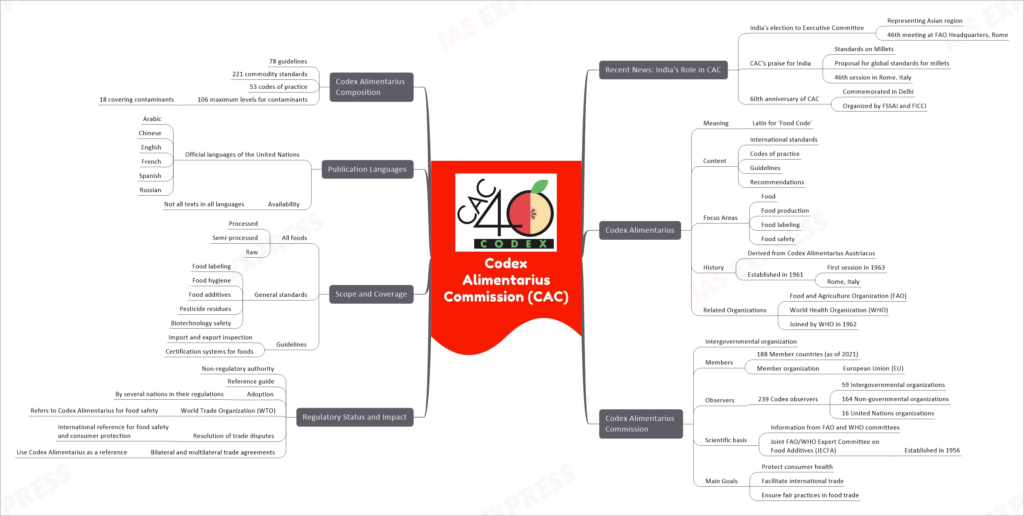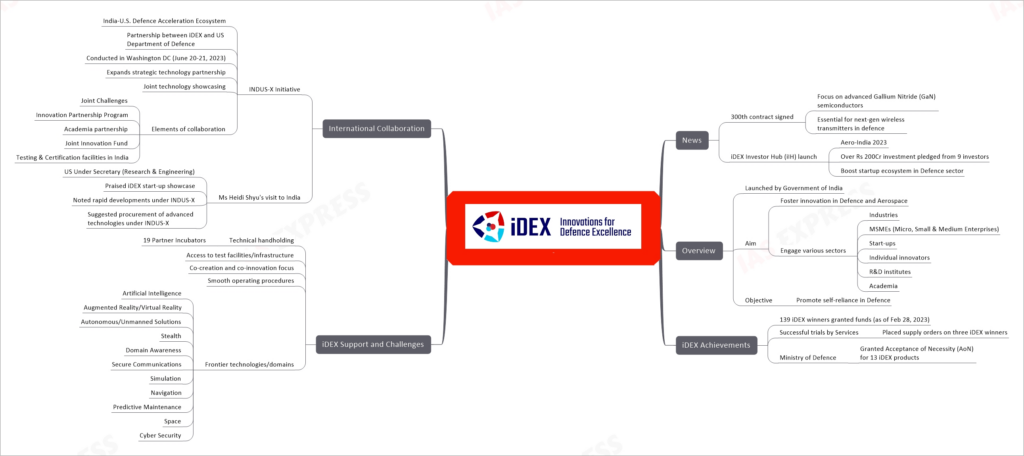[Newsbits] 3.12.2023 – International Maritime Organisation (IMO), Codex Alimentarius Commission (CAC) & more

Introduction
In recent news, India’s re-election to the International Maritime Organisation (IMO) Council for the biennium 2024-25 has underscored its substantial role in international seaborne trade. To delve into the significance of this event, we must first understand the core aspects of the IMO Council and its functions.
International Maritime Organisation (IMO)
The International Maritime Organisation, often referred to as IMO, stands as a specialized agency under the United Nations (UN) umbrella. Established in 1948, its inaugural meeting took place in 1958. IMO’s headquarters are situated in London, United Kingdom, and it boasts a membership of 175 Member States and 3 Associate Members.
Purpose and Focus
The primary purpose of the IMO is to develop a regulatory framework for shipping, addressing crucial areas such as:
- Maritime Safety
- Environmental Concerns
- Legal Matters
- Technical Cooperation
- Maritime Security
- Shipping Efficiency
Governing Structure
The IMO’s governing structure consists of two significant bodies:
- Assembly: This body convenes every two years.
- Council: Comprising 40 Member States elected by the Assembly, the Council acts as the governing body between Assembly sessions.
Leadership
The Secretary-General of the IMO is responsible for its administration. The current Secretary-General is Kitack Lim from South Korea, serving from 2016 to 2023. His successor, Arsenio Dominguez, will assume office in 2024.
Secretariat
The IMO Secretariat is composed of international civil servants and is organized into various divisions, including:
- Marine Safety
- Environmental Protection
- Conference Section
Technical Work
Technical work within the IMO is carried out by five principal committees:
- Maritime Safety Committee (MSC)
- Marine Environment Protection Committee (MEPC)
- Legal Committee
- Technical Cooperation Committee (with a focus on capacity building)
- Facilitation Committee (simplifying documentation and formalities in shipping)
Maritime Safety Committee (MSC)
The Maritime Safety Committee (MSC) holds the distinction of being the most senior technical committee within the IMO. It has oversight of nine sub-committees and is responsible for initiating new topics related to maritime safety. Some of the broad topics it addresses include the human element on casualties and the development of the ship management code.
Sub-committees
The MSC oversees the following sub-committees:
- Human Element, Training and Watchkeeping (HTW)
- Implementation of IMO Instruments (III)
- Navigation, Communications and Search and Rescue (NCSR)
- Pollution Prevention and Response (PPR)
- Ship Design and Construction (SDC)
- Ship Systems and Equipment (SSE)
- Carriage of Cargoes and Containers (CCC)
Recent News: India’s Role in IMO Council
India’s re-election to the IMO Council for the biennium 2024-25 is a noteworthy event in the maritime world. This achievement highlights India’s prominent role in global maritime trade. Here are some key details:
- Term: India’s term on the IMO Council is for the biennium 2024-25.
- Votes: India received 157 out of 167 votes, showcasing strong support from the international maritime community.
- Category: India is among the ten states with the largest interest in international seaborne trade.
- Context: This re-election underscores India’s significant influence and contributions to the regulation and promotion of safe and efficient shipping practices on the global stage.
Conclusion
India’s re-election to the IMO Council serves as a testament to its growing prominence in the realm of international maritime trade and safety. As a key player within the IMO, India’s role in shaping the future of global shipping regulations and standards is set to become even more pronounced in the coming years.
Introduction
In a recent development, India has played a notable role in the Codex Alimentarius Commission (CAC). India’s active participation and contributions to CAC’s initiatives highlight the nation’s growing influence in the global food regulatory landscape. Noteworthy events include India’s election to the Executive Committee, CAC’s recognition of India’s standards on millets, and the commemoration of CAC’s 60th anniversary in Delhi.
Codex Alimentarius
Meaning
The term “Codex Alimentarius” originates from Latin, translating to the ‘Food Code.’ It represents a comprehensive set of international standards, codes of practice, guidelines, and recommendations relating to various aspects of the food industry.
Content
Codex Alimentarius encompasses a wide range of content, including:
- International standards
- Codes of practice
- Guidelines
- Recommendations
Focus Areas
The primary focus areas of Codex Alimentarius include:
- Food
- Food production
- Food labeling
- Food safety
History
The roots of Codex Alimentarius can be traced back to the Codex Alimentarius Austriacus. It was officially established in 1961, with its inaugural session taking place in 1963 in Rome, Italy.
Related Organizations
Codex Alimentarius Commission collaborates closely with various international bodies, including:
- Food and Agriculture Organization (FAO)
- World Health Organization (WHO)
- WHO joined the Codex Alimentarius Commission in 1962, reinforcing its global significance.
Commission’s Main Goals
The Codex Alimentarius Commission operates with several primary objectives:
- Protecting consumer health
- Facilitating international trade
- Ensuring fair practices in food trade
Codex Alimentarius Commission
The Codex Alimentarius Commission functions as an intergovernmental organization with a broad membership base.
Members
As of 2021, the commission comprises 188 member countries. Additionally, the European Union (EU) is recognized as a member organization.
Observers
The commission also welcomes observers from various sectors:
- 239 Codex observers
- 59 Intergovernmental organizations
- 164 Non-governmental organizations
- 16 United Nations organizations
Scientific Basis
The scientific foundation of the Codex Alimentarius Commission is built upon information derived from FAO and WHO committees. One notable committee is the Joint FAO/WHO Expert Committee on Food Additives (JECFA), established in 1956.
Regulatory Status and Impact
Despite being a non-regulatory authority, the Codex Alimentarius Commission wields considerable influence in the realm of international food standards and safety.
- It serves as a reference guide, often adopted by individual nations in their regulations.
- The World Trade Organization (WTO) looks to Codex Alimentarius for guidance on food safety matters.
- Codex Alimentarius serves as an international reference for resolving trade disputes and safeguarding consumer protection.
- Bilateral and multilateral trade agreements frequently reference Codex Alimentarius standards.
Scope and Coverage
Codex Alimentarius has a comprehensive scope, encompassing all types of foods, whether processed, semi-processed, or raw. It offers general standards and guidelines across various domains, including:
- Food labeling
- Food hygiene
- Food additives
- Pesticide residues
- Biotechnology safety
Additionally, Codex Alimentarius provides guidelines for import and export inspection and certification systems for foods.
Publication Languages
To ensure global accessibility, Codex Alimentarius materials are available in the official languages of the United Nations:
- Arabic
- Chinese
- English
- French
- Spanish
- Russian
However, not all texts are available in all languages, highlighting the complexity of the content.
Codex Alimentarius Composition
The Codex Alimentarius is a vast compilation of standards and guidelines, including:
- 78 guidelines
- 221 commodity standards
- 53 codes of practice
- 106 maximum levels for contaminants
- Covering 18 different types of contaminants
Conclusion
In conclusion, the Codex Alimentarius Commission, with its rich history and extensive reach, plays a pivotal role in shaping global food standards and safety regulations. Its collaborative efforts with international organizations, diverse membership base, and comprehensive content make it an indispensable entity in the realm of food safety and trade. India’s recent involvement and contributions underscore the evolving dynamics of this influential commission, as it continues to safeguard consumer health and promote fair practices in the global food industry.
Introduction
In recent news, Innovations for Defence Excellence (iDEX) has marked significant milestones, including the signing of its 300th contract, with a particular focus on advanced Gallium Nitride (GaN) semiconductors, essential for next-generation wireless transmitters in the defense sector. Additionally, the launch of the iDEX Investor Hub (iIH) at Aero-India 2023, with over Rs 200 crore investment pledged from nine investors, aims to bolster the startup ecosystem in the defense sector.
Overview
Innovations for Defence Excellence (iDEX), initiated by the Government of India, serves as a pivotal platform with a clear aim and objective:
- Launched by Government of IndiaiDEX was conceived with the goal of fostering innovation in the Defense and Aerospace sectors.
- AimThe primary aim of iDEX is to nurture innovation and creativity in the defense and aerospace domains, actively engaging various sectors, including industries, MSMEs (Micro, Small & Medium Enterprises), startups, individual innovators, R&D institutes, and academia.
- ObjectiveAt its core, iDEX strives to promote self-reliance in the defense sector, reducing reliance on foreign imports and boosting indigenous innovation.
iDEX Achievements
iDEX has already made significant strides in promoting innovation within the defense sector:
- 139 iDEX winners granted funds (as of Feb 28, 2023)This demonstrates a substantial investment in innovative solutions.
- Successful trials by ServicesThe services have shown confidence in iDEX innovations by placing supply orders with three iDEX winners.
- Ministry of DefenceThe Ministry of Defence has granted Acceptance of Necessity (AoN) for 13 iDEX products, highlighting their potential significance in defense applications.
iDEX Support and Challenges
To ensure its mission’s success, iDEX provides crucial support while facing specific challenges:
- Technical handholdingiDEX collaborates with 19 Partner Incubators, offering technical guidance and support to budding innovators.
- Access to test facilities/infrastructureAccess to testing facilities and infrastructure is essential for validating innovations and bringing them to market.
- Co-creation and co-innovation focusiDEX encourages collaborative efforts in innovation, fostering co-creation and co-innovation among various stakeholders.
- Smooth operating proceduresStreamlining operational processes ensures that innovations move swiftly from concept to reality.
- Frontier technologies/domainsiDEX delves into cutting-edge domains such as Artificial Intelligence, Augmented Reality/Virtual Reality, Autonomous/Unmanned Solutions, Stealth, Domain Awareness, Secure Communications, Simulation, Navigation, Predictive Maintenance, Space, and Cyber Security, driving advancements in defense technology.
International Collaboration
iDEX’s reach extends beyond India’s borders through international collaboration:
- INDUS-X InitiativeThe India-U.S. Defence Acceleration Ecosystem, known as INDUS-X, is a partnership between iDEX and the U.S. Department of Defense. It recently conducted joint activities in Washington DC (June 20-21, 2023), expanding the strategic technology partnership between the two nations.
- Elements of collaborationINDUS-X involves Joint Challenges, an Innovation Partnership Program, academia partnership, Joint Innovation Fund, and the establishment of testing & certification facilities in India.
- Ms. Heidi Shyu’s visit to IndiaNotably, Ms. Heidi Shyu, the U.S. Under Secretary (Research & Engineering), visited India and commended the iDEX startup showcase. She acknowledged the rapid developments under INDUS-X and suggested the procurement of advanced technologies under this collaborative initiative.
In conclusion, Innovations for Defence Excellence (iDEX) is making substantial contributions to the defense and aerospace sectors in India. With its achievements, support mechanisms, focus on frontier technologies, and international collaborations, iDEX is paving the way for innovative solutions that enhance the country’s self-reliance and technological prowess in defense.
If you like this post, please share your feedback in the comments section below so that we will upload more posts like this.



